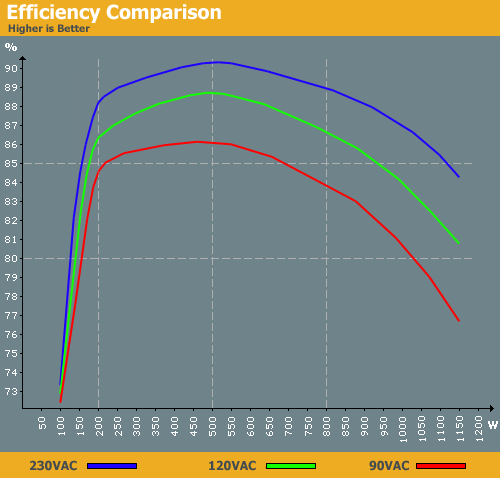Enermax Revolution 85+ High Efficiency PSU
by Christoph Katzer on November 6, 2008 4:15 AM EST- Posted in
- Cases/Cooling/PSUs
Efficiency and PFC

This efficiency graph surely does not need much explanation. The Enermax Revolution 85+ is the most efficient power supply we have tested to date. It reaches a little higher than 90% efficiency with 230VAC, but even with 120VAC it still manages to hit almost 89% efficiency. With 90VAC up to 86% efficiency is possible, which is simply amazing.
About the only negative is that you need a load of at least 200W to reach the optimal efficiency range. However, you can still get 80% efficiency with 120W to 150W (depending on input voltage), but then we don't expect anyone running a load of 150W to be interested in a 1000W PSU. Beyond the 200W mark, this power supply is more efficient than most other power supplies -- almost regardless of rating or load. The Enermax Revolution 85+ continues to improve on this result up to the peak efficiency reached at around 500W.

We were hoping for a similarly impressive power factor correction result, but it's merely the equal of the other high-end power supplies we've tested in this area. The 120VAC and 90VAC are above .99 for almost the entire test, which is good. As usual, 230VAC struggles but still starts at .964.










49 Comments
View All Comments
xaris106 - Thursday, November 6, 2008 - link
sorry if my english are not good. its not my first language.Aside from that i know what a kilowatt and losses are. I`m not saying they did something wrong. I just wanted some more info on the matter for the pros and cons...
araczynski - Thursday, November 6, 2008 - link
i suppose they're putting all that tech into the very high end market for the same reason as all other techs do; its easy to charge an extra premium (above the normal premium) from those buyers.sooner or later the technology will trickle down into the 'normal' market, where there is more serious volume.
but that's alright, the very high end market just ends up paying our share of the R&D costs that get passed on to them, instead of us.
'bleeding edge' or something they call it? 'bleeding' green :)
JarredWalton - Thursday, November 6, 2008 - link
The real problem is trying to get all of the necessary parts into a "reasonable" PSU, like something in the 600W or lower range for example. I'd guess they probably put around $100-$150 worth of parts and components into this design, making it fit for the high-end but not much else. If you want to sell 500W PSUs, pricing needs to be below $100 for sure to be competitive, and it's just not all that practical to get there with top-end components (IMO).Keep in mind that most people run PSUs at around 50% load if they want peak efficiency, so this PSU is really ideal for anyone running a ~500W system. GTX 280 SLI with an overclocked quad-core would be just about right I think... if you have enough extra HDDs. That it *can* run anything from 200W to 950W with 85% efficiency (and even beyond if you use 230VAC and want to overload the PSU) is extremely impressive.
Phew - Thursday, November 6, 2008 - link
"When I first saw the filtering stage, I asked the representatives at Enermax if CWT is the ODM"I consider myself pretty savvy about computer hardware, and I have two engineering degrees (mechanical), but that sentence was meaningless to me.
If you are going to use multiple obscure acronyms in one sentence, please at least include links to what they stand for and some description. It shouldn't take an electrical engineering degree to understand an article on a 'mainstream' computer hardware website.
yeti514 - Friday, November 7, 2008 - link
I don't know about this PSU, but the PSUs in the link below sure look like some Thermaltake units that were made by CWT to me.http://www.enermaxusa.com/catalog/product_info.php...">http://www.enermaxusa.com/catalog/produ...sCsid=e8...
nevbie - Thursday, November 6, 2008 - link
Channel Well Technologies (company..)Original Design Manufacturer (..which was the manufacturer)
Or along those lines.
Note that this is a mainstream enthusiast computer hardware website. =P
Phew - Thursday, November 6, 2008 - link
When your computer hardware website has a power supply review listed right next to a digital camera review and a Guitar Hero article, that is about as 'mainstream' as it gets.Thanks for the acronym explanation
petersterncan - Thursday, November 6, 2008 - link
I will never buy this line of PSUs unless they came out with a 300-350W model.The systems I build use on-board graphics, on-board audio, one HD, one energy efficient CPU and one optical drive. Fully configured, the systems I build for myself only use around 110 watts. Anything over 350W results in wasted electricity.
Look at the minimum power consumption and efficiency at low power draws! That's the most relevant info for me when selecting a PSU.
Calin - Thursday, November 6, 2008 - link
You can have in USA electrical power on 240V. And the power source will go just as well at 220/230V of Europe as with 240Vstrikeback03 - Thursday, November 6, 2008 - link
Problem would probably be getting the proper cable for the US. Might have to make it yourself.